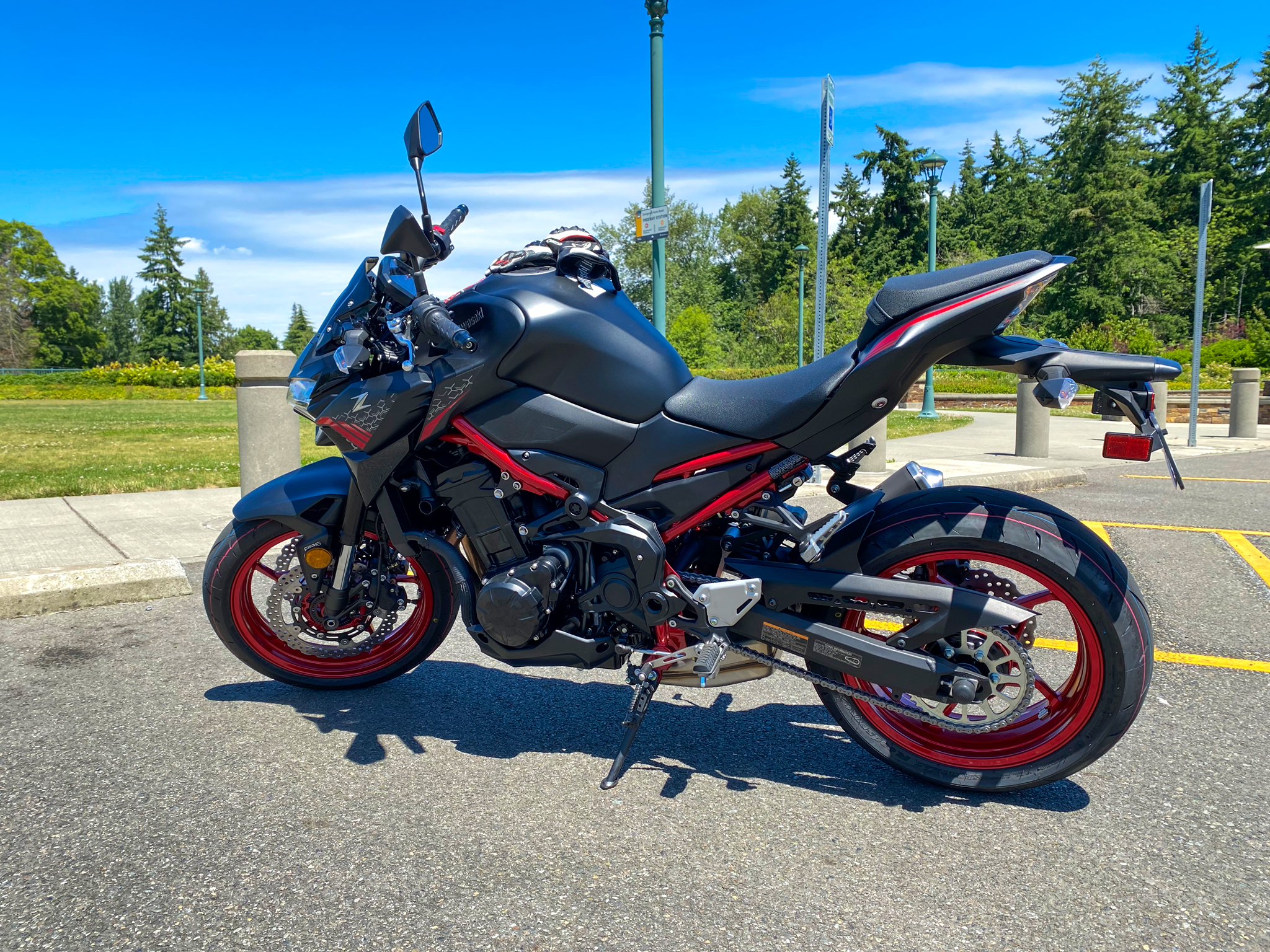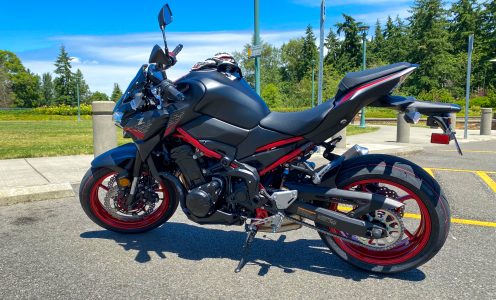This riding season I upgraded my motorcycle from Ninja 400 ABS to Z900 ABS. I was looking for more power and a more comfortable riding posture. My new Z900 delivered both. We clocked a few thousand miles across Washington together. It gave me an opportunity to contrast my Ninja 400 experience with Z900. I distilled them into this article for other riders looking to upgrade. I won’t be talking tech specs or showing pictures of a nice TFT display – there are plenty of those on the internet. This post is about various aspects of experience riding the motorcycle.
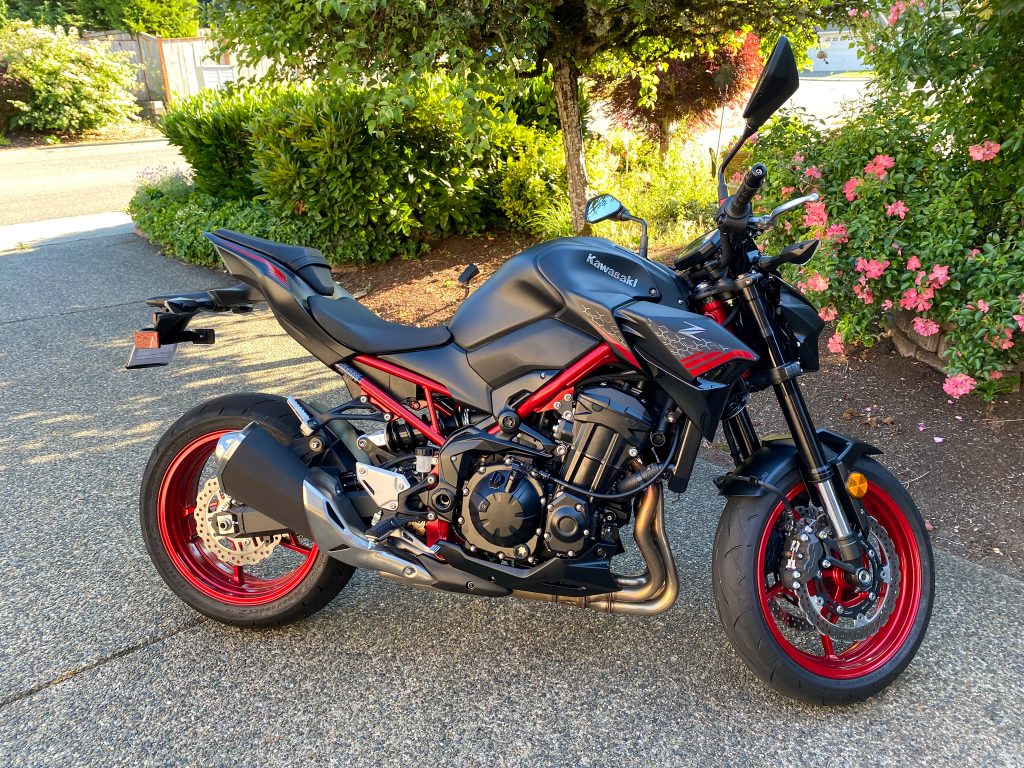
Riding posture
★★★★★
This is a different class of a motorcycle than Ninja 400 so it isn’t strictly an apples-to-apples comparison. I am going to disregard the rules and compare them anyway – a ride is a ride.
Z900 is slightly taller than Ninja 400, but nothing an average human can’t handle. Because the motorcycle is taller it is more comfortable for taller riders, like me. I enjoy not having to bend my knees too much. I flat foot this bike without effort.
The riding posture is more upright and considerably more comfortable. Lean angle is less aggressive than Ninja 400. I can ride 2-3 hours before I feel a need to pull over and stretch. Shoulders no longer hurt while riding, mostly butt. The seat is sturdy and one’s behind gets numb due to constrained blood circulation. I am sure it can be fixed with a custom seat upgrade.
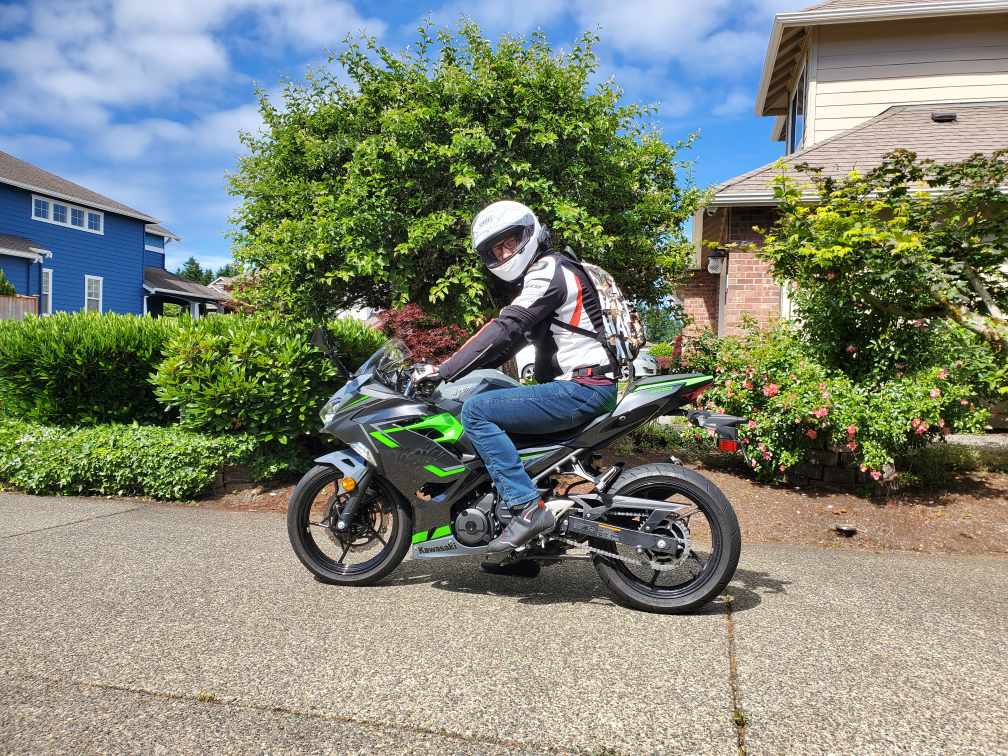
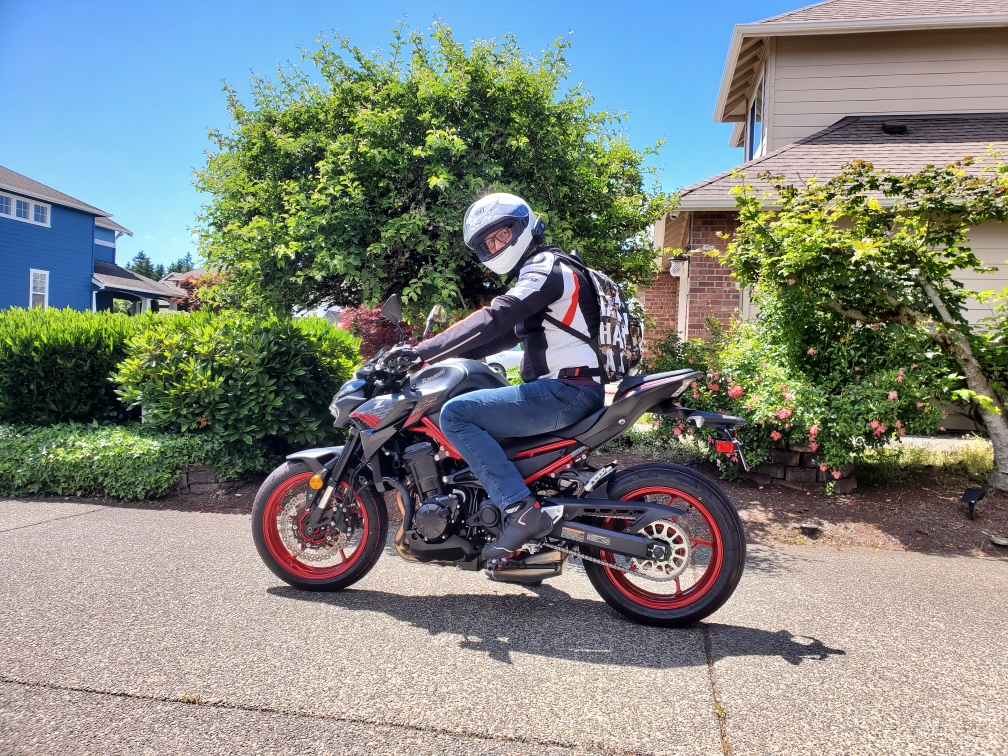
Weight
★★★★★
You can feel additional 100lbs of weight when turning or leaning. It is a bit less flicky than Ninja 400 but all within desired controllability range. You need to put more effort to catch the bike when it starts leaning to the side while stopped. It takes more hand-foot coordination to prevent rolling back when stopped on the hill.
Due to the extra weight, it takes more effort to roll this motorcycle in neutral when the engine is off or the clutch is disengaged. I am a reasonably fit guy, who hiked the crazy incline of the Koko head crater on Oahu, however, I am unable to push this bike up the 10% hill. Lastly, my beautiful wife is helping me put the bike on the stand for chain service. She exerts more energy pushing the stand down to lift the bike up.
Having said that, extra weight is advantageous in side-wind conditions. I was thrown around the freeway like a fly on Ninja 400 when riding in eastern Washington. Not anymore – Z900 is more stable. Additional stability helps when riding by the truck that creates turbulence in the air.
Power
★★★★★
Hands down, this bike has enough torque to create a safe margin around you on the freeway. It isn’t even fair to compare to Ninja 400 because they have vastly different engine displacements. Ninja 400 has 399cc while Z900 sports a whopping 948cc. Ninja 400 yields 28.0 ft-lbs of torque @ 8000 RPM, while Z900 yields 73.1 ft-lbs.
Riding on the freeway is effortless. Motorcycle maintains 60 mph in 6th gear at 4500 RPM. The engine is running quietly keeping the noise low and the right wrist relaxed. A quieter engine makes distance riding more enjoyable due to lower vibrations.
Acceleration feels instantaneous – a slight twist of the throttle and you can increase the distance with the car behind you within 2-3 seconds. Passing a car going below the speed limit via an oncoming traffic lane is safer because it is faster. The throttle responds immediately, the engine revs up, and the bike accelerates. You can complete the maneuver within 10 seconds – start to finish.
Engine braking is less effective without downshifting. Motorcycle weight tends to overpower the engine if all you do is close the throttle. This wasn’t the case with Ninja 400 – closing the throttle could bring the bike to a standstill.
You feel the power from the moment you start the engine. The motorcycle wants to roll even when the clutch is disengaged.
Fuel economy
★★★★★
Z900 tank is slightly larger than Ninja 400 – 4.5 gallons vs 3.7 gallons. However, you could ride much farther on Ninja 400 than Z900 without refueling. Z900 consumes about 1.2 gallons of fuel per hour @ 60 mph riding steadily on the freeway.
A full tank of gas at current prices will cost you about $17 in the Seattle area. If you ride 30 minutes a day @ 30 mph on the city roads, one tank will last the entire week. If you take a joy ride into the country via hilly highways doing between 50 mph – 70 mph, be prepared to refuel every 3 hours.
On average, Z900 delivers about 45 miles per gallon (according to the Rideology app on my phone).
Ownership cost
★★★★★
I will admit, upgrade to Z900 did sting a bit. On-going maintenance cost is comparable to Ninja 400, but certain categories of expenses are higher.
To start with, Z900 brand new off the lot costs about $11K with fees and taxes and without a trade-in. Of course, there are great used motorcycles on the market and trade-in will bring the cost down. Best time to buy – end of the season. Do not be like me, do not buy a motorcycle in March.
Be prepared to shell out for insurance about 2x. Because this motorcycle has a larger engine displacement, insurance companies deem it riskier and charge higher premiums. My monthly insurance charge is about $100. Cost-conscious individuals may want to cancel their insurance off riding season and save 6 months of fees. Why pay for a bike that never leaves the garage?
Annual Z900 license tabs in Washington state cost about $215, out of which $99 are RCA tax.
Z900, like any other Kawasaki, or a motorcycle in general, requires oil changes. Oil change intervals are reasonable – the first change at 600 miles, then at 3000 miles, afterward every 5000 miles. The best way to go is to change the oil yourself. Labor costs at the motorcycle dealerships are sky-high, up to $120/hour. Instead of shelling $300+ for an oil change, you can buy a Kawasaki oil change kit and do it yourself. It’ll cost you $50.
Every 600 miles you need to clean and lube the chain. I have been using Motul Chain Clean for $12 and Motul Racing Chain Lube for $15. Chain clean lasts about 2-3 times, lube covers about 3-4, similar to Ninja 400. If you manage to put 3,000 miles on your motorcycle in the riding season, it will cost you about 2 cans of each to maintain the chain, which totals $54.
A few one-time costs should be considered as well for a complete picture:
- Motorcycle stand for the front and rear wheels. I use Venom Sport Bike stand, which costs $100.
- Swing arm stand screws (like these ones) – $20.
- Battery tender to keep the battery charged off season – $40.
- Motorcycle cover to keep the dust off while it is parked – $23.
If you are a beginner rider, check out my post about other costs associated with the motorcycle.
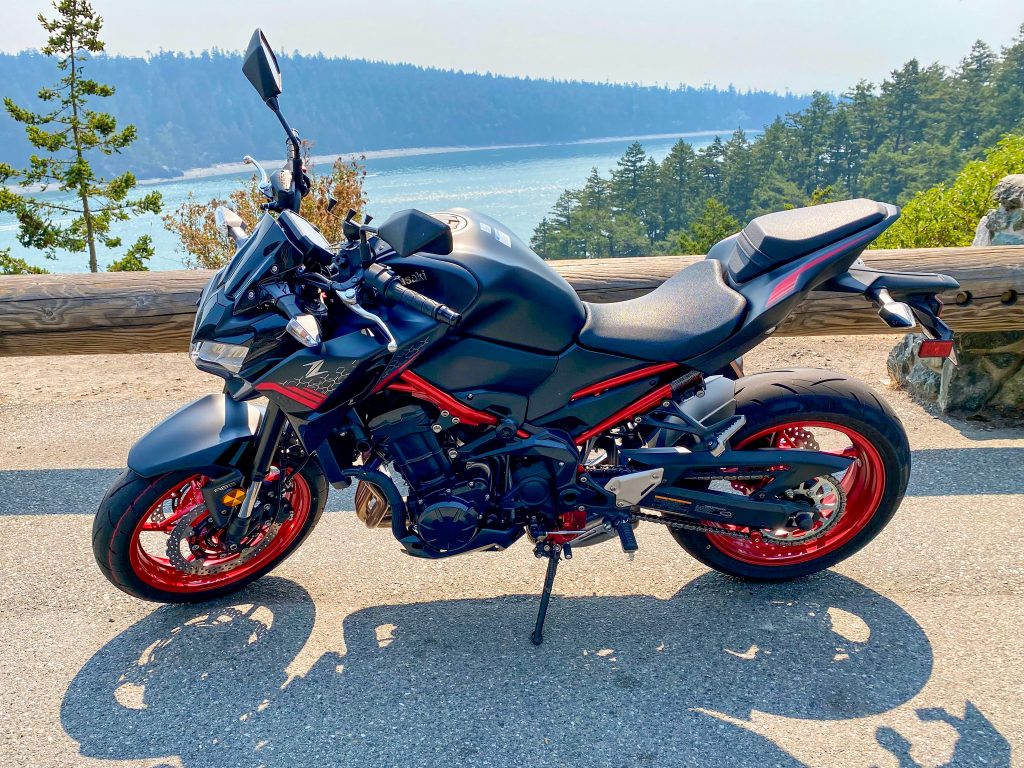
Vibrations
★★★★★
My experience riding various classes of motorcycles is limited so take this information with a grain of salt.
Ninja 400 was very comfortable on the streets with almost no vibrations. On the freeway, however, vibrations of footpegs numbed the feet in 2-3 hours of riding. I had to change feet positions quite often to keep the blood flowing.
Z900 has a tangible vibration on the clip-ons. In about 1 hour of freeway riding my hands start to go numb. I can deal with the left wrist easily by resting it on the tank. Unfortunately, there is no easy fix for the right wrist. It controls the throttle and must always be engaged. I end up changing the grip angle constantly to keep the blood flowing. The risk of this vibration is that you won’t notice when you lose control of the motorcycle because your hands are numb.
On the upside, there is no vibration on the footpegs. I suspect rubber padding dampens it but I haven’t tried ripping it off to see the difference.
Aerodynemics
★★★★★
Neither Ninja 400 nor Z900 offer any wind protection out of the box. If you are looking for wind protection – buy a car. On the motorcycle, it gets chilly very quickly, even if the ambient temperature is comfortable. It was 65F the other day and I had to put on 4 layers of clothing to stay warm while crossing Snoqualmie pass at 60 mph.
What I am about to say is not scientific and highly subjective so take it for what it’s worth.
I noticed that Z900 has better aerodynamics than Ninja 400 in two ways – less wind resistance and better wind deflection away from your body. When riding Ninja 400 directly into the wind, most of the wind was hitting my neck and helmet. It made riding in the wind a constant neck muscle exercise. I had to fight to keep looking straight. On Z900, riding in the comparable wind, I do not have the same experience. My suspicion is that Z900 directs wind equally towards the entire torso and head, reducing neck strain. Ninja 400 seems to concentrate wind deflection towards the helmet and away from the waist. Core muscles are stronger than neck muscles and the core is closer to the center of gravity which makes it more stable. As such, I prefer Z900 over Ninja 400 design.
Real estate
★★★★★
Z900 has plenty of room to install clip-on accessories. I was finally able to mount my cell phone holder and use it for navigation. I had no space for it on the Ninja 400.

Z900 has a generous number of accessories from Kawasaki and 3rd parties – radiator protector, tail tidy, Akrapovic exhaust, USB port, etc. If you have the time, the money, and energy to customize this bike, you will not be bored.
Rideology app
★★★★★
It is worth sharing a quick word on the app. I love the idea of connecting your bike computer to the phone to track and tune bike performance. The idea is amazing and I wish more manufacturers took it to heart. Kudos to Kawasaki for the initiative.
There is one glaring problem with the app that basically renders it useless for a good chunk of functionality. I call it “Stop your bike”.
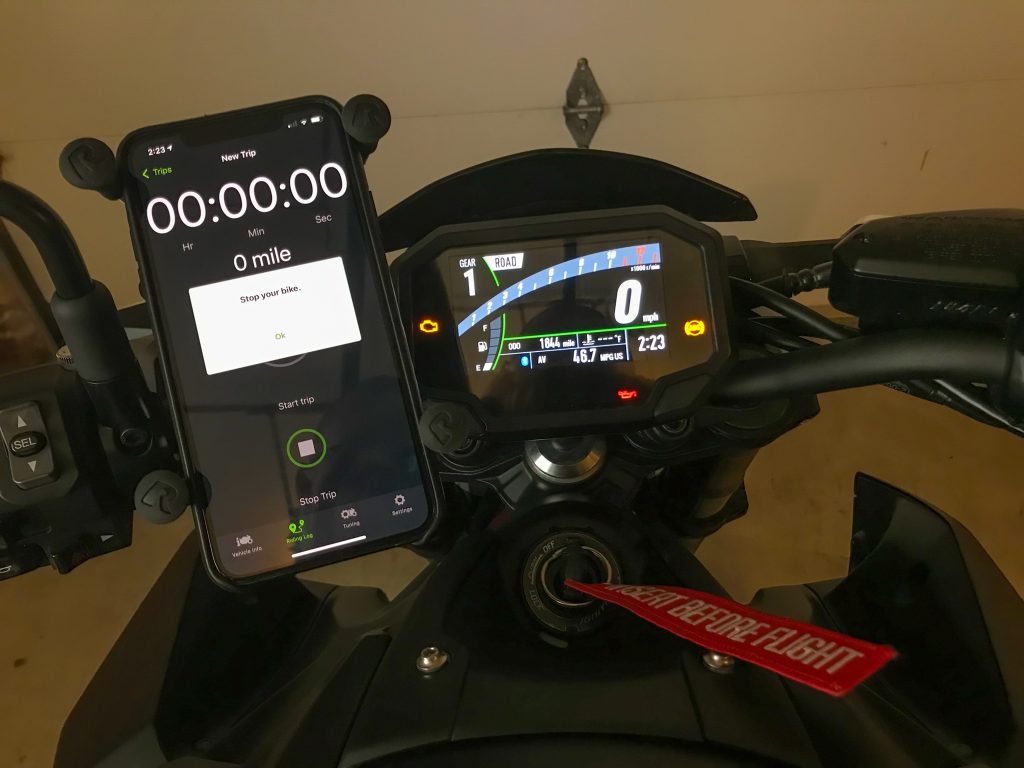
The app firmly believes that my bike is running, even though it can’t be more stopped than this. The engine is off, the bike is on the stand. The computer must be on to connect to the app via Bluetooth. Turning off the computer disconnects the phone completely. Unfortunately, even in this state, the app wouldn’t allow me to start a trip. All of those capabilities that we see in the YouTube video about the app are inaccessible to me. I hope someone else has better luck.
This app needs more work to be truly useful:
- It must not have basic bugs like this.
- It needs to detect when the motorcycle starts moving and star/stop tracking the trip automatically. I shouldn’t need to pull the phone to click the button. Most riders are wearing gloves which makes holding a phone inconvenient.
- It needs to sync the data into the cloud to view from the computer.
- Bike location tracking must work even when the bike is off. It is a bit useless when it only works when the bike is on and in the bluetooth range of the phone.
Overall, good intention, poor implementation. Keep up the work Kawasaki.
First motorcycle
★★★★★
This is not a great choice for the first motorcycle, but it is a great upgrade. This bike is too heavy and too powerful to be safe and useful for a beginner rider.
As a beginner, you want to focus on technique and really polish your riding skills. It would be hard to do on Z900 because it is bulky. You would be terrified to drop it every time you practice a tight turn. In fact, I am not sure I would pass an MSF exam on Z900 today.
The throttle is sensitive and power comes immediately. Learning friction zone and power control are better done on a less powerful motorcycle in the 250 – 400 CC range.
Are you guaranteed to kill yourself on Z900 as a first motorcycle? Probably not. But there are many things worse than death – for example, dropping your bike 10 miles away from the dealership, or breaking your leg in front of your crush. It is a risk game. Z900 would be above my safety tolerance for the first motorcycle.
Attention
It is a question of personal preference whether you like pedestrians and drivers admiring your bike or not. I have noticed an uptick in people walking up to the bike to look at it or take a picture when it is parked. I am an introvert and prefer to be left alone while riding. You may actually enjoy the attention that leads to making more acquaintances. Regardless of which camp you are in, this bike will draw eyes to it. Do not expect a huge splash of attention as if you were riding a custom motorcycle, however.
Conclusion
I absolutely love this bike, even in light of the challenges and issues mentioned in this post. No bike will be perfect in all aspects and each bike has a purpose. Turns out I am a naked bike kind of rider.
